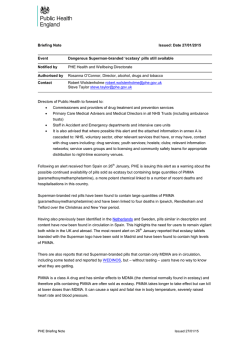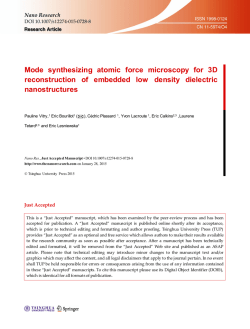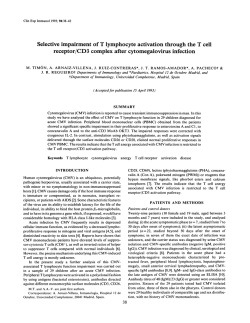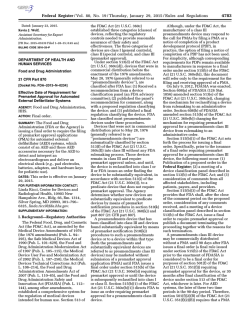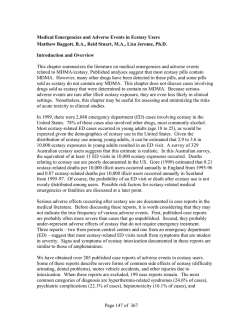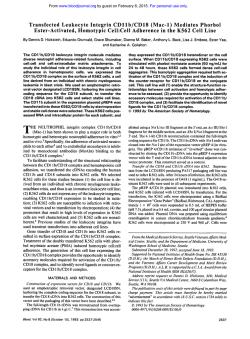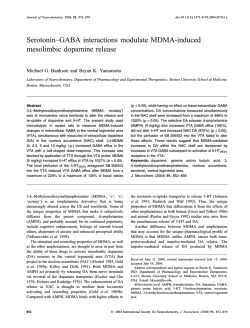
A fatal paramethoxymethamphetamine intoxication
Legal Medicine 5 (2003) S138–S141 www.elsevier.com/locate/legalmed A fatal paramethoxymethamphetamine intoxication Ju¨rgen Becker*, Peter Neis, Jo¨rg Ro¨hrich, Siegfried Zo¨rntlein Institute for Legal Medicine, Johannes Gutenberg University, Am Pulverturm 3, 55131 Mainz, Germany Abstract During the last years in Germany a marked increase in the use of amphetamines such as 3,4-methylenedioxymethamphetamine (MDMA, ecstasy) has been observed. The use of these recreational drugs is especially common among young people participating in rave parties. Occasionally ring-methoxylated phenethylamine derivatives like paramethoxymethamphetamine (PMMA) or paramethoxyamphetamine (PMA) are found in street drugs offered as ecstasy. These compounds exhibit a higher toxicity than the methylenedioxyamphetamine derivatives. We report on the death of a 22-year-old man after the ingestion of ecstasy pills containing PMMA and PMA. The PMMA concentration in femoral blood was 0.85 mg/l. Besides PMA (0.61 mg/ l), amphetamine (0.21 mg/l), benzoylecgonine (,0.01 mg/l) and ethanol (0.46 ‰) were found in the blood. The case reflects the well-known fact that street drugs offered as ecstasy pills contain not necessarily MDMA but frequently differ in composition even if they have the same logo. Users of these pills therefore always take the risk of consuming pills with dangerous lifethreatening ingredients. In many laboratories paramethoxyamphetamines are not detectable in routine analytical procedures. If the cause of an intoxication cannot be discovered by analytical routine methods, rarely occurring designer drugs such as PMA or PMMA should also be kept in mind. q 2003 Elsevier Science Ireland Ltd. All rights reserved. Keywords: Forensic toxicology; Lethal designer drug intoxication; Paramethhoxymethamphetamine; Paramethoxyamphetamine 1. Introduction The ring-methoxylated phenethylamine derivatives paramethoxyamphetamine (PMA) and paramethoxymethamphetamine (PMMA) are structurally related to mescaline and to the compounds of the so-called ecstasy group including 3,4-methylenedioxyamphetamine (MDA), 3,4-methylenedioxymethamphetamine (MDMA) and 3,4-methylenedioxyethylamphetamine (MDEA). PMA and PMMA, two powerful stimulants, are cheaper and easier to manufacture than ecstasy and far more dangerous. These drugs all exhibit hallucinogenic properties. During the last years in Germany a marked increase in the use of ampheta* Corresponding author. Tel.: 149-6131-393-0036; fax: 1496131-393-2181. E-mail address: [email protected] (J. Becker). mines such as ecstasy has been observed. The use of these recreational drugs is especially common among young people participating in rave parties. Occasionally PMA and PMMA occur among pills being sold as ecstasy. Many of these pills are stamped with a threediamond Mitsubishi logo. 2. Case history A 22-year-old man died after the ingestion of ecstasy pills containing PMMA and PMA. The young man was witnessed to be hallucinating at a party. Later, he started to convulse and developed respiratory distress. An ambulance was called but an attempted resuscitation failed. Police inquiry revealed that the deceased had a past history of occasional use of cannabis. At autopsy no evidence of any disease 1344-6223/03/$ - see front matter q 2003 Elsevier Science Ireland Ltd. All rights reserved. doi:10.1016/S134 4- 6223(02)0009 6-2 J. Becker et al. / Legal Medicine 5 (2003) S138–S141 that might have caused death was found. A typical mark of venipuncture was seen on the left arm, but inquiry revealed that it occurred during the reanimation attempt. No signs of violence were observed. Microscopic examination was not performed. Intoxication was suspected because of severe edema of the brain and congestion of the inner organs. Samples taken for toxicological analysis included heart blood, femoral blood and urine. 3. Experimental Screening of urine was performed using fluorescence polarization immunoassay (FPIA) on the Abbott ADx analyzer (amphetamines, barbiturates, benzodiazepines, cannabinoids, cocaine, methadone, opiates, tricyclics), the automated drug-profiling system REMEDi (Bio-Rad Laboratories) and gas chromatography–mass spectrometry (GC/MS). Ethanol was quantified by means of standard GC (head space) and enzymatic (ADH) methods. Quantification was done with a routinely used analytical method for the simultaneous determination of acidic, neutral and basic drugs [1,2]. The method is based on a solid phase extraction procedure using C18 SPE columns. In a first extraction step acidic and neutral drugs (e.g. cannabinoids, benzodiazepines) were eluted. Subsequently, the remaining basic drugs were extracted at alkaline pH. Both extracts were evaporated under a slight stream of nitrogen at 30 8C. The basic drugs were derivatized with pentafluoropropionic anhydride (PFPA) and pentafluoropropanol (PFPOH). The analyses were carried out with GC/MS in selected ion monitoring (SIM) mode using deuterated drugs as internal standards. EI ionization (70 eV) was used. In a first GC/MS run extracts were analyzed for amphetamine, methamphetamine, MDA, MDMA, MDEA, MBDB, benzoylecgonine, methylecgonine, cocaine, methadone, EDDP, morphine, 6acetylmorphine codeine and dihydrocodeine. In a second GC/MS run the basic extracts were analyzed for PMA and PMMA. For GC/MS analysis a gas chromatograph HP 6890 with auto-sampler, mass-spectrometer HP 5973 (Hewlett-Packard, Palo Alto, CA) and HP-5 MS capillary column (30 m, 0.25 mm internal diameter, 0.25 mm film thickness) was used. The carrier gas was He (constant flow: 1 ml/min), the S139 injection volume 1 ml (splitless injection), the injector temperature 250 8C and the transfer line temperature 280 8C. The oven temperature program was 2 min isothermally at 60 8C, 40 8C/min to 170 8C, 8 8C/ min to 270 8C and 13 min isothermally at 270 8C. The following masses were measured in SIM mode: PMA-PFP: 121 (target), 148 and 311 (qualifier); PMMA: 204 (target), 121 and 148 (qualifier). For quantification the peak areas of the target ions were used. Quantification was based on peak area ratios relative to the internal standard MDMA-D5 (target ion 208). A seven-point linear calibration curve was obtained for each drug. Human serum, which tested negative for drugs by means of GC/MS, was used for the preparation of the calibration standards. The calibration levels for PMA and PMMA were 0, 10, 20, 40, 60, 80 and 100 ng/ml. The different calibration levels were obtained by spiking blank serum with appropriate amounts of a methanolic solution containing 1 ng/ ml of PMA and PMMA. The regression coefficients were 0.998 (PMA) and 0.999 (PMMA). The limits of detection (LOD) and quantification (LOQ) were calculated statistically from the calibration data according to Funk et al. [3]. These limits are dependent on the chosen concentration ranges and are usually significantly higher than the limits of detection, which are estimated by means of signal-to-noise ratios. For PMA the LOD was 4.4 ng/ml and the LOQ 16.2 ng/ml. For PMMA the LOD was 2.6 ng/ml and the LOQ 9.8 ng/ml. The intra-assay coefficients of variation were 8.7% (PMA) and 6.2% (PMMA). The day-to-day coefficients were 11.2% (PMA) and 6.9% (PMMA). 4. Results and discussion Routine screening of urine by immunoassay techniques revealed the presence of a high level of amphetamines and trace amounts of cocaine metabolites. HPLC screening of urine with REMEDi identified parahydroxymethamphetamine. It is used in Germany for the treatment of hypotension and available without prescription (Pholedrin). The second larger peak could not be identified by the REMEDi library. The following GC/MS screening of urine then identified high amounts of PMA and PMMA as well as amphetamine and small amounts of benzoylecgonine. S140 J. Becker et al. / Legal Medicine 5 (2003) S138–S141 Table 1 Toxicology results Compound Femoral blood (mg/l) Heart blood (mg/l) Urine (mg/l) PMMA PMA Amphetamine Benzoylecgonine Ethanol (‰) 0.85 0.61 0.21 , 0.01 0.46 2.12 1.94 0.51 , 0.01 10.22 6.37 2.39 0.02 1.18 before death, because only traces of the cocaine metabolite benzoylecgonine were present in blood and urine. Amphetamine might have been a constituent of the PMMA/PMA pills. The differences between drug concentrations in heart blood and peripheral blood can be explained by a postmortem redistribution. Investigations of fatal intoxications have shown that doses of approximately 50 mg PMA or PMMA could lead to a spontaneous life-threatening increase of blood pressure and body temperature. The overall concentration of amphetamines in peripheral blood (1.6 mg/l) is rather high and evidential for a dangerous overdose. The reason may be the delayed stimulating and hallucinogenic effects of PMMA and PMA compared to MDMA. Ecstasy users therefore are easily tempted to take some more pills to get the desired action. In Table 2 the results of the investigations of some other PMA intoxications are listed. In Table 2 PMA intoxications; blood concentrations and other toxicological findings Fig. 1. Mass spectra of PMA, PMA-PFP, PMMA and PMMA-PFP. PMA and PMMA are structurally close related to parahydroxymethamphetamine and show a high degree of similarity in their UV-spectra. Thus REMEDi is not able to differentiate between parahydroxymethamphetamine and PMA by using UV-spectra for identification. Mass spectra are necessary for the identification (Fig. 1). The toxicological results obtained with the GC/MS methods described above are summarized in Table 1. The deceased had obviously used different drugs and alcoholics. Cocaine was consumed a longer time PMA (mg/l) Other drugs Present case 0.61 Case 2 a 1.1 Case 3 0.1 Felgate et.al. [4] (10 cases) 0.24–4.9 PMMA, amphetamine, benzoylecgonine MDMA, MDA, MDEA MDMA, MDA, MDEA Amphetamine, methamphetamine, MDMA a Private communication from S. Steinmeyer, Institute for Legal Medicine, Universita¨ t des Saarlandes, Homburg/Saar, Germany. J. Becker et al. / Legal Medicine 5 (2003) S138–S141 cases 2 and 3 an 18-year-old female and her 23-yearold friend together took some ‘Mitsubishis’ containing PMA and MDMA. The woman (case 2) was found dead next morning and the man was admitted to hospital and survived. Postmortem blood of the deceased and blood of her friend taken 18 h after administration were analyzed. Some other fatal PMA intoxications in Australia were reported by Felgate et al. [4]. These cases reflect the well-known fact that street drugs offered as ecstasy pills contain not necessarily MDMA but frequently differ in composition even if they have the same logo. Users of these pills therefore always take the risk of consuming pills with dangerous life-threatening ingredients. In spite of serious warnings about the life-threatening dangers of some compounds in detailed trip reports or official drug information web sites, severe to lethal intoxications still occur. PMMA and PMA are not widely distrib- S141 uted and are therefore not often detected by routine analytical procedures. If the cause of an intoxication cannot be found by routine analytical methods, a rare case of designer drug intoxication should be kept in mind. References [1] Becker J, Ro¨ hrich J, Zo¨ rntlein S. Simultaneous determination of frequently abused illicit drugs in serum and other body fluids. IV International Symposium Advances in Legal Medicine 22.09–25.09 in Mainz. Rechtsmedizin 1999;9(Suppl 1):A30. [2] Ro¨ hrich J, Zo¨ rntlein S, Po¨ tsch L, Skopp G, Becker J. Effect of the shampoo Ultra clean on drug concentrations in human hair. Int J Legal Med 2000;113:102–106. [3] Funk W, Dammann V, Donnevert G. Qualita¨ tssicherung in der analytischen chemie. Weinheim: CH Verlag, 1992. [4] Felgate HE, Felgate PD, James RA, Sims DN, Vozzo DC. Recent paramethoxy-amphetamine deaths. J Anal Toxicol 1998;22:169–172.
© Copyright 2025
